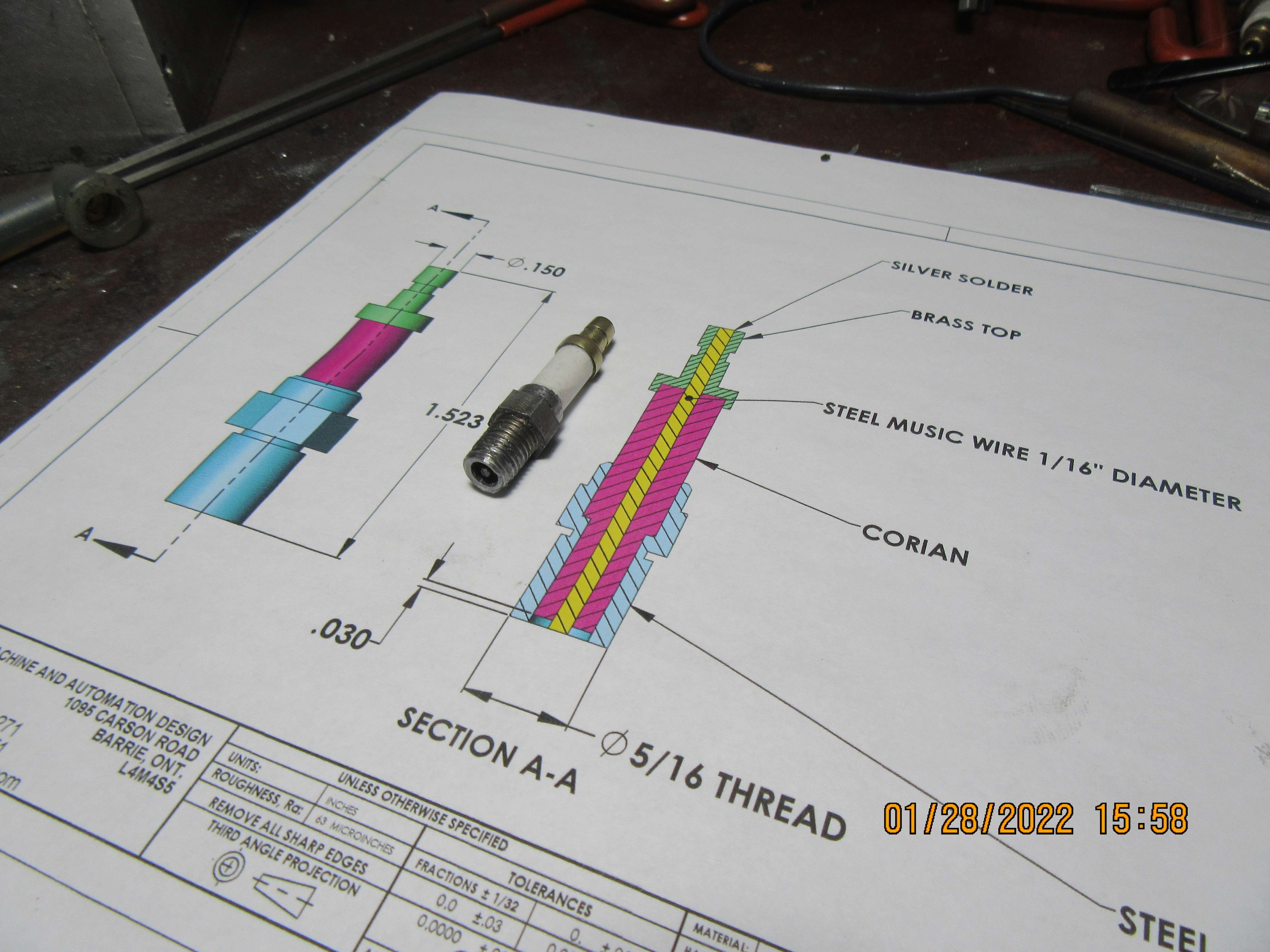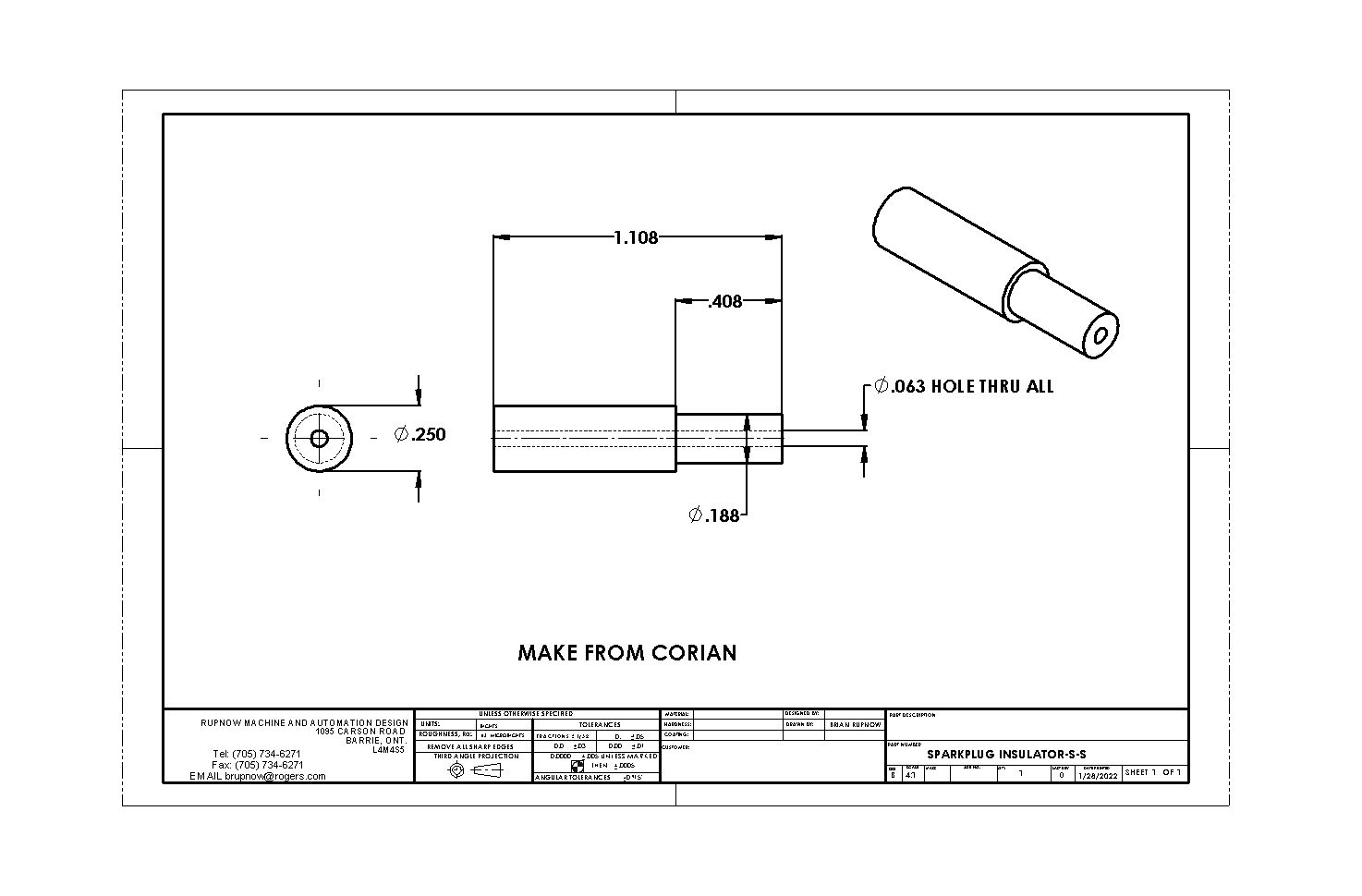1/16 inch is awfully large for an electrode. You may be having trouble because the walls of the insulator are getting thin. My largest electrode is .040 and smallest is .015 inch. Also the drill bit needs to be sharp, like brand new sharp. Corian does not like dull cutters.
You are using an out of date browser. It may not display this or other websites correctly.
You should upgrade or use an alternative browser.
You should upgrade or use an alternative browser.
Shop built sparkplugs for model engines
- Thread starter Brian Rupnow
- Start date

Help Support Home Model Engine Machinist Forum:
This site may earn a commission from merchant affiliate
links, including eBay, Amazon, and others.
Because music wire is cheap, comes in hundreds of sizes, and will last the life of the model.
I have yet to make a sparkplug, but it's on my list of things to do. Having read about different types of insulator materials, I am wondering if anyone has tried PEEK or some of the other high temperature plastics? PEEK in particular seems to be a good candidate, and while not cheap seems affordable in the small quantities required.
Sid--I didn't have any tungsten. Almega--There are no threads on the Corian. To machine the Corian, first turn it to overall diameter and length. Then drill the 1/16" hole. Then insert the center electrode full length into the hole--no epoxy yet. Then machine the area which is turned down to 3/16" diameter. No texturing is necessary. The material was 1018. The spark jumps from the center electrode to the body. Apparently it is okay to use J.B.Weld to "glue" these parts together. I strongly advise that you buy a finished sparkplug from a supplier. The hours you spend making your own sparkplug will far outweigh the expense of buying one.
Last edited:
Surly the metal in the JB Weld is only a problem if you get a big blob of it where you don't want it. A very thin smear against the metal is not going to cause a short as it will be no greater distance to the actual metal.
Having said that where do you get your details that it will cause a short? I know of one supplier of model engines that sell it and suggest it's use as an electrical insulator.
Having said that where do you get your details that it will cause a short? I know of one supplier of model engines that sell it and suggest it's use as an electrical insulator.
Last edited:
About the JB Weld and metal content, wouldn't it only be in contact with the metal and and the insulator at the separate bonding surfaces between the body and the electrode and would not bridge across the electrode to the body at any point? At least that is how it appears to me from your drawing. What am I missing? I do understand the time aspect but this is a hobby and consumption of time and gaining experience/knowledge is the point. If I was trying to make a living off my machining capabilities, I would starve to death in a very short time.

$24.99
$34.99
Bowl Sander Tool Kit w/Dual Bearing Head & Hardwood Handle | 42PC Wood Sander Set | 2" Hook & Loop Sanding Disc Sandpaper Assortment | 1/4" Mandrel Bowl Sander for Woodturning | Wood Lathe Tools
Peachtree Woodworking Supply Inc

$89.99
Outdoor Wood Boiler Water Treatment Rust Inhibitor- AmTech 300 & Test Kit
Alternative Heating & Supplies

$519.19
$699.00
FoxAlien Masuter Pro CNC Router Machine, Upgraded 3-Axis Engraving All-Metal Milling Machine for Wood Acrylic MDF Nylon Carving Cutting
FoxAlien Official

$94.99
$109.99
AHS Woodmaster 4400 Maintenance Kit for Outdoor Wood Boiler Treatment
Alternative Heating & Supplies

$39.99
$49.99
Sunnytech Low Temperature Stirling Engine Motor Steam Heat Education Model Toy Kit For mechanical skills (LT001)
stirlingtechonline

$45.99
Sunnytech Mini Hot Air Stirling Engine Motor Model Educational Toy Kits Electricity HA001
stirlingtechonline

$39.58
$49.99
Becker CAD 12 3D - professional CAD software for 2D + 3D design and modelling - for 3 PCs - 100% compatible with AutoCAD
momox Shop
![DreamPlan Home Design and Landscaping Software Free for Windows [PC Download]](https://m.media-amazon.com/images/I/51kvZH2dVLL._SL500_.jpg)
$0.00
DreamPlan Home Design and Landscaping Software Free for Windows [PC Download]
Amazon.com Services LLC

$99.99
AHS Outdoor Wood Boiler Yearly Maintenance Kit with Water Treatment - ProTech 300 & Test Kit
Alternative Heating & Supplies
Just looked on JB Weld's website. They say it won't conduct electricity and is considered an insulator which would tend to agree with the supplier of engine kits.
This fellow has a great video on making sparkplugs. Most of what I've shown here is taken directly from the video. The video is a two part series.
I just looked up the j.b.weld specs, and you're right. It says it is a good insulator, so that is what I will use.
- Joined
- Jul 16, 2007
- Messages
- 3,059
- Reaction score
- 1,191
As with a lot of processes in model making there are many ways to achieve somewhat the same end. This is the process that I use and Steve Huck makes his the same way.
The first picture show the components needed for crimping the plug flange over the shoulder on the insulator. There is the guide sleeve, the plug thread bushing and the crimping die.
The next 2 photos are of an old plug body that I take to shows to show people how the plugs are made. In the first picture you can see the thing flange around the top of the plug body.
The next photo shows the plug screwed into the threaded bushing.
The next photo shows the plug/bushing inserted into the guide sleeve.
The next photo is of the crimping die. I made this from W-1 drill rod and hardened it. I have made them just from drill rod without hardening but after a number of plugs they start to cut a step into the chamfer, so that is why I now harden them. The chamfer is about 30 degrees from the horizontal. The hole in the crimping die is just a little bigger than the insulator diameter (couple of thousands for clearance)
The next photo shows the crimping die inserted into the bushing.
The last photo is one of my 1/4-32 size plugs with the flange crimped in place. No epoxy, no JB Weld and no leaks.
The first picture show the components needed for crimping the plug flange over the shoulder on the insulator. There is the guide sleeve, the plug thread bushing and the crimping die.
The next 2 photos are of an old plug body that I take to shows to show people how the plugs are made. In the first picture you can see the thing flange around the top of the plug body.
The next photo shows the plug screwed into the threaded bushing.
The next photo shows the plug/bushing inserted into the guide sleeve.
The next photo is of the crimping die. I made this from W-1 drill rod and hardened it. I have made them just from drill rod without hardening but after a number of plugs they start to cut a step into the chamfer, so that is why I now harden them. The chamfer is about 30 degrees from the horizontal. The hole in the crimping die is just a little bigger than the insulator diameter (couple of thousands for clearance)
The next photo shows the crimping die inserted into the bushing.
The last photo is one of my 1/4-32 size plugs with the flange crimped in place. No epoxy, no JB Weld and no leaks.
Attachments
- Joined
- Jul 16, 2007
- Messages
- 3,059
- Reaction score
- 1,191
Oh and by the way I use .025 music wire for my electrodes. Some of my insulators are .700 long and I drill the whole thing with a .025 drill using a fairly fast spindle speed and just pushing the tailstock by hand so I can peck in and out. As the drill get deeper into the Corian you'll need to clean the swarf from the flutes otherwise it will bind up. I just put a dab of spit on the dill as I get deeper into the Corian. This helps the Corian from sticking to the drill. I have made about 80 plugs this way with never a broken drill. I solder the electrode into the brass top leaving it long. I then insert it into the plug and keep adjusting the length until I get the proper gap. I have even made some with threaded brass caps (3-48 thread) When the electrode wears I just unscrew it, heat it up, pull the electrode wire out a little bit and readjust the gap.
- Joined
- Jul 16, 2007
- Messages
- 3,059
- Reaction score
- 1,191
George do you silver solder the electrode into the cap or just use electrical/plumbing solder which is what I have used on the lower number of plugs that I have made. I can't really see the need for silver solder as the Corian will have long since burned away before the plug gets hot enough to melt the solder.
jasonb - I do use that version quite a bit for other projects where temperature is not an issue, usually like body putty to clean up the lines of whatever I'm working on, before painting. I was concerned about using it in areas of engines where things get pretty hot. Have you had experience with it in hot areas?
So here we are---a finished sparkplug. If I made these and sold them, I'd have to charge at least $300 each, considering the time it took me to make it. The components are J.B.Welded together. Does it work?--Not sure yet, but after that j.b. weld sets up for an hour I'll find out. Again, I caution you, if you need a sparkplug for your model engine, then buy it from somebody who does this as a business. The last plug I made was about 12 or 13 years ago. The next plug I build may be 12 or 13 years from now. If you want to make one just to see if you can, well now you have the drawings.


This is the drawing of the Corian insulator. And I must say, Corian is the worst damned stuff I ever worked with. It took me three different attempts before I made one that didn't crack or split. That's okay though, I doubt I will make anymore sparkplugs.


George--a huge "Thank you" for all the explanation and pictures.---Brian
Steve- I yield to your expertise of course.Because music wire is cheap, comes in hundreds of sizes, and will last the life of the model.
I used tungsten welding electrodes.
Brian does have a TIG welder now. Might as well use those electrodes for something!!
I used .040.
Sid
Similar threads
- Replies
- 11
- Views
- 3K
- Replies
- 95
- Views
- 12K
- Replies
- 10
- Views
- 2K




















































